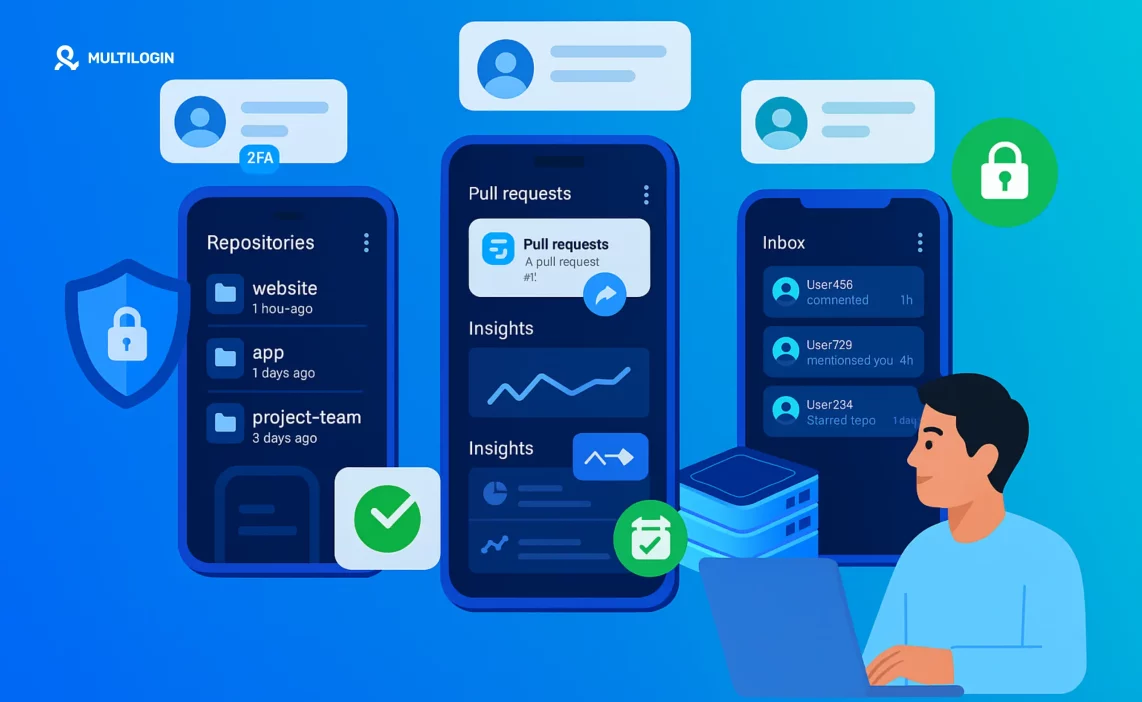Managing multiple GitHub accounts on the same machine is a common challenge for developers. Whether you’re juggling personal projects and work repositories, managing client accounts as a freelancer, or contributing to open-source while maintaining private work, GitHub’s single-account limitation can be frustrating.
The good news? There are several proven methods to manage multiple GitHub accounts seamlessly. From SSH key configuration and Git credential management to browser-based solutions using antidetect technology, this comprehensive guide covers every approach.
This article answers all your questions: Does GitHub allow multiple accounts? Can you be logged into multiple accounts simultaneously? How do you configure GitHub Desktop, VS Code, and command-line Git for multiple accounts? Let’s dive in.
Does GitHub Allow You to Be Logged Into Multiple Accounts?
Short answer: Yes, but with limitations.
GitHub’s official stance is that you can have multiple accounts, but their tools and web interface are designed around single-account usage. Here’s what this means:
GitHub.com (Web Browser):
- You can only be logged into one GitHub.com account at a time in a standard browser
- Switching accounts requires logging out and logging back in
- Solution: Use multiple browsers, browser profiles, or antidetect browsers (more on this later)
GitHub Desktop:
- Supports one GitHub.com account + one GitHub Enterprise Server account simultaneously
- Cannot add multiple GitHub.com accounts natively
- Solution: Use command-line Git with SSH keys or browser-based workflows
VS Code:
- Now supports multiple GitHub accounts (as of 2023)
- Can switch between accounts for different repositories
- Solution: Configure multiple accounts in VS Code settings
Command-Line Git:
- Fully supports multiple accounts through SSH keys and Git configuration
- Most flexible approach for developers
- Solution: Configure SSH keys and conditional Git includes
Can I Have Multiple GitHub Accounts?
Yes, GitHub allows users to have multiple accounts. Common scenarios include:
- Personal + Work accounts: Separate professional and personal projects
- Multiple clients: Freelancers managing different client repositories
- Open-source + Private: Contributing to public projects while maintaining private work
- Testing/Development: Separate accounts for testing and production
- Organization management: Personal account + organization admin accounts
GitHub’s Terms of Service permit multiple accounts as long as you’re not using them to abuse the platform, circumvent restrictions, or violate policies.
Method 1: SSH Keys for Multiple GitHub Accounts (Command-Line)
The most reliable method for developers. This approach uses different SSH keys for each GitHub account, allowing seamless switching without logging in and out.
Step 1: Generate SSH Keys for Each Account
Open your terminal and generate separate SSH keys:
# Generate SSH key for personal account
ssh-keygen -t ed25519 -C “[email protected]” -f ~/.ssh/id_ed25519_personal
# Generate SSH key for work account
ssh-keygen -t ed25519 -C “[email protected]” -f ~/.ssh/id_ed25519_work
Note: Press Enter when prompted for a passphrase (or set one for extra security).
Step 2: Add SSH Keys to SSH Agent
Start the SSH agent and add your keys:
# Start SSH agent
eval “$(ssh-agent -s)”
# Add personal key
ssh-add ~/.ssh/id_ed25519_personal
# Add work key
ssh-add ~/.ssh/id_ed25519_work
Step 3: Add Public Keys to GitHub Accounts
Copy each public key and add it to the corresponding GitHub account:
# Copy personal public key
cat ~/.ssh/id_ed25519_personal.pub
# Copy work public key
cat ~/.ssh/id_ed25519_work.pub
Then:
- Log into each GitHub account
- Go to Settings → SSH and GPG keys → New SSH key
- Paste the corresponding public key
- Give it a descriptive title (e.g., “Personal Laptop” or “Work MacBook”)
Step 4: Create SSH Config File
Create or edit ~/.ssh/config:
# Personal GitHub account
Host github.com-personal
HostName github.com
User git
IdentityFile ~/.ssh/id_ed25519_personal
# Work GitHub account
Host github.com-work
HostName github.com
User git
IdentityFile ~/.ssh/id_ed25519_work
Step 5: Clone Repositories with Custom Hosts
When cloning repositories, use your custom host names:
# Clone personal repository
git clone [email protected]:username/personal-repo.git
# Clone work repository
git clone [email protected]:company/work-repo.git
Step 6: Configure Git User Per Repository
Set the correct Git user for each repository:
# In personal repository
cd personal-repo
git config user.name “Personal Name”
git config user.email “[email protected]”
# In work repository
cd work-repo
git config user.name “Work Name”
git config user.email “[email protected]”
Pro tip: Use conditional includes in your global Git config to automatically set user info based on directory:
# Edit ~/.gitconfig
[includeIf “gitdir:~/personal/”]
path = ~/.gitconfig-personal
[includeIf “gitdir:~/work/”]
path = ~/.gitconfig-work
Then create ~/.gitconfig-personal and ~/.gitconfig-work with respective user information.
Method 2: GitHub Desktop Multiple Accounts
The limitation: GitHub Desktop officially supports one GitHub.com account + one GitHub Enterprise Server account simultaneously. You cannot add multiple GitHub.com accounts natively.
Workaround 1: Use Command-Line Git with GitHub Desktop
- Configure SSH keys as described in Method 1
- Clone repositories using command-line with custom SSH hosts
- Open cloned repositories in GitHub Desktop
- GitHub Desktop will work with repositories regardless of which account they’re associated with
Workaround 2: Switch Accounts Manually
- Go to File → Options → Accounts (Windows) or GitHub Desktop → Preferences → Accounts (Mac)
- Sign out of current account
- Sign in with different account
- Repeat when you need to switch
Downside: This is tedious and time-consuming for frequent switching.
Workaround 3: Use Multiple Browsers for Authentication
When GitHub Desktop prompts for authentication:
- Use different browsers (Chrome, Firefox, Edge) for different accounts
- Or use browser profiles (Chrome profiles, Firefox containers)
- Authenticate in the appropriate browser when prompted
Method 3: VS Code Multiple GitHub Accounts
Good news: VS Code now supports multiple GitHub accounts natively (as of 2023).
How to Add Multiple GitHub Accounts in VS Code
- Open VS Code
- Click the Account icon (bottom-left corner)
- Click “Sign in with GitHub”
- Authenticate with your first account
- Click the Account icon again
- Select “Sign in with another account”
- Authenticate with your second account
Switching Between Accounts in VS Code
- Click the Account icon (bottom-left)
- Select the account you want to use
- VS Code will use that account for Git operations, GitHub Copilot, etc.
Per-Repository Account Configuration
VS Code respects your Git configuration, so if you’ve set up per-repository user info (Method 1, Step 6), VS Code will use the correct account automatically.
Troubleshooting VS Code Account Issues
If VS Code “sticks” to one account:
- Sign out of all accounts: Click Account icon → Sign out
- Clear VS Code credentials:
- Windows: Delete credentials from Windows Credential Manager
- Mac: Delete credentials from Keychain Access
- Linux: Delete ~/.config/Code/User/globalStorage/github.auth
- Restart VS Code
- Sign in again with the correct account
Method 4: Browser-Based Multiple GitHub Accounts
The simplest approach for web-based GitHub usage.
Option 1: Multiple Browsers
Use different browsers for different accounts:
- Chrome: Personal account
- Firefox: Work account
- Edge: Client account
Pros: Simple, no configuration needed
Cons: Requires multiple browsers, can be confusing
Option 2: Browser Profiles
Most browsers support multiple profiles:
Chrome:
- Click your profile icon (top-right)
- Select “Add” to create a new profile
- Sign into different GitHub accounts in each profile
Firefox:
- Type about:profiles in the address bar
- Create new profiles
- Launch Firefox with different profiles for different accounts
Pros: Single browser, separate sessions
Cons: Requires switching profiles, limited to one active profile at a time
Option 3: Multilogin (Best Solution for Professional Use)
The professional approach: Multilogin is an antidetect browser designed for managing multiple online accounts simultaneously.
Why Multilogin is superior for GitHub multiple accounts:
- Simultaneous sessions: Work with multiple GitHub accounts at the same time in separate browser profiles
- Complete isolation: Each profile has unique fingerprints, cookies, and sessions
- Team collaboration: Share GitHub access with team members without sharing passwords
- No account linking: GitHub can’t detect that profiles are from the same machine
- Professional workflow: Designed for developers, agencies, and businesses managing multiple accounts
How to use Multilogin for GitHub accounts:
- Create separate browser profiles for each GitHub account
- Log into different GitHub accounts in each profile
- Work simultaneously without logging in and out
- Maintain separate sessions indefinitely
Pricing:
- Trial: €1.99 for 3 days
- Pro 10: €5.85/month when billed annually (10 profiles)
- Perfect for developers managing multiple GitHub accounts
Use case: A freelance developer manages 5 client GitHub accounts + personal account. Instead of constantly logging in and out, they use 6 Multilogin profiles, each logged into a different GitHub account. They can view all accounts simultaneously, switch instantly, and never mix up commits.
Try Multilogin now and streamline your GitHub multi-account workflow.
Method 5: Git Credential Manager
For HTTPS authentication (alternative to SSH keys).
Configure Multiple Credentials
Git Credential Manager can store multiple GitHub credentials:
Install Git Credential Manager:
# Windows: Included with Git for Windows
# Mac: brew install git-credential-manager
# Linux: Download from GitHub releases
- Configure credential helper: git config –global credential.helper manager
- Clone with HTTPS: git clone https://github.com/username/repo.git
- Authenticate when prompted: Git Credential Manager will save credentials
- For different accounts: Use per-repository configuration: cd repo git config credential.https://github.com.username “work-username”
Using Multiple GitHub Accounts on Same Machine: Best Practices
- Use Descriptive SSH Key Names
Name your SSH keys clearly: id_ed25519_personal, id_ed25519_work, id_ed25519_client1
- Organize Repositories by Directory
Structure your projects:
~/personal/
~/work/
~/clients/client1/
~/clients/client2/
Use Git conditional includes to automatically set user info based on directory.
- Use Git Aliases
Create aliases for common operations:
git config –global alias.personal “config user.email ‘[email protected]'”
git config –global alias.work “config user.email ‘[email protected]'”
Then run git personal or git work in repositories to quickly set the correct user.
- Verify Before Committing
Always check your Git configuration before committing:
git config user.name
git config user.email
- Use Separate SSH Keys for Security
Never reuse SSH keys across accounts. Each account should have its own unique key pair.
- Document Your Setup
Keep a README in your home directory documenting which accounts use which SSH keys and hosts.
Can You Have Multiple GitHub Accounts? (Legal and Policy Considerations)
Yes, GitHub explicitly allows multiple accounts. From GitHub’s Terms of Service:
- You may create multiple accounts for legitimate purposes
- You must not use multiple accounts to abuse the platform
- You must not circumvent restrictions or bans
- Each account must have a unique email address
Legitimate use cases:
- Personal and professional separation
- Managing client projects
- Testing and development environments
- Open-source and private work separation
Prohibited use cases:
- Creating accounts to evade bans
- Manipulating voting or starring systems
- Circumventing rate limits
- Harassing other users
As long as you’re using multiple accounts for legitimate purposes, GitHub fully supports this practice.
👉 Don’t risk bans: Try Multilogin and keep your accounts undetected.
Frequently Asked Questions About How to Manage Multiple GitHub Accounts
GitHub.com allows only one account login per browser session. However, you can use multiple browsers, browser profiles, or antidetect browsers like Multilogin to be logged into multiple accounts simultaneously.
Yes, GitHub explicitly allows multiple accounts as long as they’re used for legitimate purposes and not to abuse the platform or circumvent restrictions.
VS Code now supports multiple GitHub accounts natively. Click the Account icon (bottom-left), sign in with your first account, then click again and select “Sign in with another account” to add additional accounts.
GitHub Desktop officially supports one GitHub.com account + one GitHub Enterprise Server account. For multiple GitHub.com accounts, use command-line Git with SSH keys or switch accounts manually in GitHub Desktop settings.
For developers: SSH key configuration (Method 1). For non-technical users or those needing simultaneous browser access: Multilogin antidetect browser.
Conclusion
Managing multiple GitHub accounts on the same machine is not only possible—it’s straightforward with the right approach. For developers comfortable with the command line, SSH key configuration provides the most flexible and reliable solution. For those needing browser-based access to multiple accounts simultaneously, Multilogin offers a professional-grade solution.
The key is choosing the method that fits your workflow:
- Developers: SSH keys + Git configuration (Method 1)
- VS Code users: Native multiple account support (Method 3)
- GitHub Desktop users: SSH keys + command-line cloning (Method 2)
- Browser-based users: Multilogin for simultaneous access (Method 4)
- HTTPS users: Git Credential Manager (Method 5)
Whichever method you choose, you’ll be able to seamlessly manage personal projects, work repositories, client accounts, and open-source contributions without the constant hassle of logging in and out.
Need to manage multiple GitHub accounts in your browser simultaneously? Try Multilogin now and experience the professional way to handle multiple accounts.



